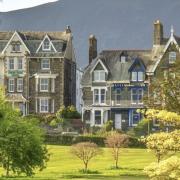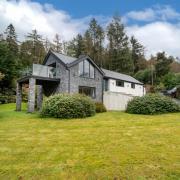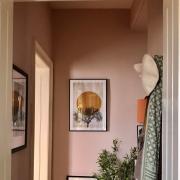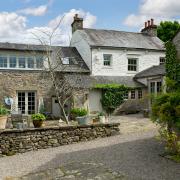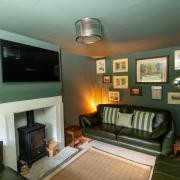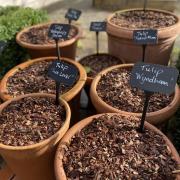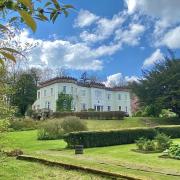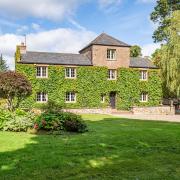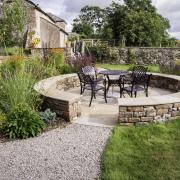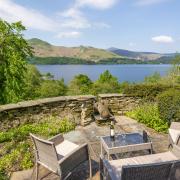Janet Queen grabs a handful of compost, lifts it to her nose and inhales deeply before crumbling it away between her fingers. “Hmmm, it’s got a sweetness,” she says with approval on a sunny but still chilly April morning. There has been a frost, and there is a light breeze too, but signs of life are all around. Walking through the gardens at Rose Castle she touches the lichen on an apple tree, rubs the leaves of a gooseberry bush and exclaims joyfully at the sight of a ladybird in a flower border.
These are the small details captured by the gardener’s senses but Janet, who will have been here for 30 years next June, has her eye on the bigger picture too. While ensuring every plant, shrub and tree is thriving now, from the smallest specimen in an historic wall to a 300-year-old oak tree, her sights are drawn further, both practically and metaphorically.
Janet takes the long view, and she also likes a long view, whether it is from an upstairs window or across to Carrock Fell on the horizon. She, and her husband Jim Waugh, who was head gardener at Rose Castle before her, garden accordingly.
“When you are planning gardens, you are working in the present and relating to the past, but also working with quite a long sight to the future. I am thinking of how plants will look in 100-200 years from now. My time is just a flicker in the history of this garden.

“I have grown on some young trees from acorns and am hoping to get them planted in fields that are classed as farmland at the moment so in 300 years from now there are similar trees growing from our own stock. That is something I would really like to achieve,” she says.
Rose Castle’s history is long. Following King Henry I’s creation of the diocese and the cathedral of Carlisle in 1133, the lordship of the manor of Dalston and the site of Rose Castle was gifted by King Henry III to the bishops of Carlisle in 1230. It remained the official residence, palace and battle fortress for 63 successive bishops until the last to live there, Bishop Graham Dow, vacated in 2009.
The fourth bishop, Walter Mauclerk, was the first to occupy the site and would have had a residence built, probably in the form of a motte and bailey castle. The remains of its moat and grade I listed boundary wall with evidence of watchtowers are clues to subsequent developments when the castle became the only fortified bishop’s residence in England.
The first defensive works were built during hostilities between Scotland and England in 1296 and the castle was twice burned by the Scots, in 1333 and 1337.
The castle survived many wars, political and religious conflicts in a turbulent history, but also underwent several aesthetic and practical improvements as it became a family home as well as official residence.
Bishop William Nicholson, who served from 1702-1718, wrote the first flora of Cumbria from notebooks in which he recorded the wild flowers he came across while out on horseback. Bishop Nicholson followed Thomas Smith, another eminent botanist who built the dovecot at the castle in 1700.

Bishop John Kirby, who had been appointed for his military skills in 1332, was granted a licence to crenellate Rose Castle in 1336, but it was under Bishop Gilbert Welton that the castle went from a modest defensive building vulnerable to Scottish attacks into a substantial border fortress.
Samuel Goodenough, appointed bishop in 1807, also took great interest in maintaining the gardens of the castle.
Bishop James Newcome became the 67th bishop of Carlisle in 2009 when it was decided, in consultation with the Church Commissioners and the diocese, that he and his family would not live at Rose Castle, but instead use the former vicarage of St John’s Church, in Keswick, as the new bishop’s home.
As official residence, Rose Castle had welcomed many visitors over the centuries, notably hosting the royal court of King Edward I in 1300 and William Wordsworth in 1803.
It maintains that sense of hospitality and place of sanctuary today. Rose Castle Company bought it in 2016 for the use of the Rose Castle Foundation, which is committed to reconciliation and conflict resolution.

Led by John and Sarah Snyder, a complete renovation began in 2019 to restore the castle’s original features and bring the bedrooms, bathrooms and public rooms into the 21st century with the latest technology and comfort for guests, many of whom visit from countries around the world.
Janet has lived there, in the gardener’s cottage, since 1995 working alongside bishops Ian Harland and Graham Dow. Her knowledge of the castle and gardens and their history runs deep, and she shares it with tour groups and visitors, as well as writing a book and magazine articles, including in the past having a column in Cumbria Life.
Her love for being outside goes back to her childhood in Scotland. “My father was a forester and we lived in very isolated places where I was surrounded by nature and the natural world and I knew I wanted to work outdoors,” she says.
On leaving school she worked in the potato department at the Scottish Plant Breeding Station, in Edinburgh. She then got a job at the city’s Royal Botanic Garden where she successfully applied to study a three-year diploma.
Her first head gardener role was at Haddo House, in Aberdeenshire, which is run by the National Trust for Scotland, followed by a head gardener position in Northamptonshire and on the Isle of Lewis.
Janet and Jim were working together in Aberdeenshire when he saw the job at Rose Castle advertised. “He came as gardener and I did horticultural consultancy work and worked voluntarily in the garden at the same time while doing a lot of other garden work for the Church Commissioners.” When Jim left his role after eight years, Janet was offered the job as head gardener.

She recalls: “When the bishops were here there wasn’t really much in the way of available finance so we really just did what we could. My husband is an arboriculturist and is really well versed in tree work so when we first came we crown lifted a lot of trees to create views out and in and took out overcrowded trees.
“We started replanting specimen trees so we were very much involved in that, not in the intricacies of the decorative aspects of the garden. We were going more for structure at that stage because it was probably the best thing we could at the time with limited resources.
“At that time maintenance levels had dipped, not due to lack of expertise but lack of labour. A garden is only as good as the working hours you can put into it.
“After the First World War there wasn’t the manpower. There had been intricate parterres in the early 1900s and the outlines were still there but they were incredibly overgrown.”
The garden was productive, however. “There were large areas that produced food for the castle, a small flock of sheep and geese. There were squares where the soil was rotavated and rows of leeks, salad crops, turnips, cabbages and lots of potatoes. It wasn’t really aesthetic, but it was useful. There were the remnants of an old orchard and flower borders, but it was about production and function.
“When the bishops were here Rose Castle was a very lively place with lots of visitors coming and staying because it was the centre of the diocese. There was still a live-in housekeeper and a chauffeur. We came at the very end of the bishops being here; it was the end of an era and it was a holding action at that time.
“We knew the bishops were going so we were trying to keep it attractive, to show it off but also to maintain the idea of potential which involved keeping the views open and keeping the drive well maintained so people using the public footpath that runs past the castle would still enjoy coming.”
From 2009 until it reopened in 2022, the castle was empty and Janet took on the role of caretaker and housekeeper as well as head gardener. She was alone except for tenants in one of the cottages and volunteer Paul Silvester, who came for work experience and, having started his own business, now does contract work.
“It was a unique phase,” she recalls. “I was responsible for going around the castle and checking for leaks and mice. A lot of the time I was on my own, but it was lovely.
“Then John and Sarah came and I work closely with them. I have seen the castle come through a new renaissance.”
Janet’s experience and expertise is much valued and she has played a central role as part of The Rose Castle garden group, chaired by Jane Humphries, along with Rose Castle Foundation, to plan for the garden’s future.
Everything is tied to the vision that seeks to enhance the existing garden and grounds to best complement the work of the foundation by ensuring the estate is welcoming to diverse people and a peaceful sanctuary that helps to remove people from everyday pressures.
With her team of contractors and volunteers, Janet practices environmentally sensitive horticulture and aims to create an inspirational environment that is receptive to new ideas and gives the opportunity for residential visitors and others, including school children, to participate in horticultural and environmental projects.
The final strand of the vision is to ensure the gardens connect to the local community and the vistas of the wider landscape of the Caldew valley. Opening up and maintaining the vistas is a central theme, whether it be cutting out a square of hedge to frame a view of an oak tree in the near distance and Carrock Fell beyond or thinning out a woodland visible from upper storey bedrooms in the castle.
Historically, the gardens have been a place to walk around, where bishops and others might seek solace and hold private conversations. They retain a sense of tranquility today, a place where people can find solitude or sit together on benches, some made by Jim, at various points against a soundscape of birdsong, the clip of secateurs or the distant hum of a mower.
For Janet, there needs to be purpose to a garden. “I wanted it to be functional. There is no point in having a garden if it doesn’t have a function,” she says.
“It has to complement the events that are taking place and it has to be productive; we want to grow more produce for the kitchen. I also work closely with the foundation to make sure it is tranquil and welcoming.
“Everything is quite integrated in many ways. People who use the garden are very interested in what the gardeners and volunteers are doing here. They like to see people working and talk to the staff.
“Everybody has a high level or expertise in a certain area, that’s how it all knits together so well, gardeners, volunteers and contractors. If it wasn’t for all the hours they put in the garden wouldn’t like this. And everybody gets on really well, it’s a happy garden with a happy atmosphere. I feel so lucky to have them.”
The estate extends to around eight acres including a former paddock at the back of the castle. “We asked Bishop Ian if we could have half of it to plant a small woodland; we have oak, beech, alder, pine here. I’m isolating which trees are doing well and will be the specimens for the next 200 years, others I will take out.
“So often you see trees crammed together and nothing has space to grow. It’s not hard to take them out because when you are setting out something like this you know you are doing it to plant a choice of trees, including some just because they provide fast-growing shelter.
“I am picking the best and looking ahead especially for the oak and beech. If we left everything, nothing would grow properly. I will keep the hazels and shrubs and in time I would like the fence to come down so people can walk through the woodland.
“I’m also aware of views out of the castle when gardening. A lot of people who come here won’t walk around the gardens because it’s wet or they aren’t interested, but they will look at it from the windows so I’m always conscious of that. Things like the crab apple will stay for the present time for its blossom.
“The views out and the views in are as important as what you are seeing when you are in the garden, so we are working on the 3D aspect all the time. And it’s not just the immediate view in front of you, it’s also the outlook, what is beyond the garden. The views of Carrock Fell for instance tie the castle into its place in the landscape.”
The woodland is also a place Janet’s guineafowl and silky bantams roam free. “I like bantams because they eat slugs and they have little feet so they don’t make too much mess,” she says.
Closer to the castle entrance, running alongside the drive, is a bog garden which is home to two moor hens, frogs, dragonflies and other insects and invertebrates.
There are two greenhouses, a large, older one where seeds are planted and potting on takes place and a newer one that is being renovated ready for tomato plants.

Three compost middens are regularly replenished to provide a continuous supply to feed the productive vegetable beds, which also require a large quantity of netting to keep out rabbits and hares. On the edge of the garden is a row of beehives, which Janet, who is a member of Carlisle Beekeeping Association, looks after along with another association member.
Close to the rhubarb and gooseberry beds, a bare patch of earth awaits children from Cumwhinton School who are due the following day. “They will be planting blackcurrant bushes and potatoes, and we’ll be looking at lichen on the apple trees and what wildflowers are growing. They are having a few visits, working with the chef, the housekeeper and in the garden.
“The more people we have in the garden the better. Gardens are for people to enjoy whether they are working in them, walking past, visiting or sitting in them, otherwise there is no point in having a garden.”
This area of the garden perhaps reflects Janet’s ethos most clearly. The yew hedges are kept lower than is usual and provide a backdrop for a smart row of silver leaf pears pruned into pristine mushroom shapes. The beds are spread out and nothing is too high as the eye sweeps across the panorama; it is open and spacious, it feels like the garden can breathe.
Further on, a future project of enormous potential beckons: the Victorian walled garden is ripe for restoration but this would require significant investment.
At this time of year, the orchard is blooming; the damson blossom is finished but the apples are in their prime, rows of trees covered in pale pink, cream and white floral confetti that promises a healthy harvest later in the year.
Janet planted most around 20 years ago alongside some older trees. Around 15 varieties are represented including local favourites like Keswick and Carlisle Codlins and Egremont Russet as well as early century varieties Lord Lambourne and Reverend W Wilks.
The grass around the trees is cut at different heights to support a variety of insects and small mammals.

The rose border against a terrace wall is a relatively new feature and is doing well, with shrub varieties like Spirit of Freedom and Princess Anne under planted with Geranium renardii. “I look to see what’s growing well in other local gardens, it’s a good tip,” says Janet. “It means there’s a higher chance they will do well here. Some very heavy roses don’t do well if it’s wet, but if isn’t a wet summer they do very well.”
The ecclesiastical purple and white border is a much larger planted area on a terrace beneath a stone wall that runs along the front of the main castle lawn, above the old moat. There is no longer water in the moat but it was a very productive vegetable garden in the 1800s, with ornamental paths cut through it.
The terrace is a sun trap and a lovely promenade. “The purple and white theme was Mrs Harland’s idea so we have kept it going as a tribute to the bishops,” explains Janet. “We replanted it about four years ago with white foxgloves, White Triumphator tulips, purple phlox, Astrantia, Geranium ‘Rozanne’, alliums, white lavender, bearded iris, miniature lilac, penstemon, Cotinus and Camassia.
Placed on top of weeded ground, a composted bark mulch keeps the annual weeds at bay and provides an attractive finish.
As the border continues it takes on a ‘hotter’ hue with reds and vivid oranges of Helenium and a sorbus echoed in tulips of similar colours.
The end of the formal garden leads down to a “wilderness” area of woodland in the old moat. Further on is the clearly defined site of a 14th century ‘stew pond’. During the Middle Ages, stew ponds were common on ecclesiastical estates as stores for live fish to provide food, especially during winter. “It features a lot in written accounts of the castle. There would have been two or three at that time and we are very lucky to have such a good outline of one.”
The original grade II listed defensive wall continues around the castle gateway. Thick moss provides a rich habitat and ivy, foxgloves and ferns are also allowed to remain.
The cobbled castle entrance has been given a smart, contemporary extension since the Snyders came, complemented by a turning circle with topiary. “We wanted a front door feature that looks in keeping with the castle, and to use native species that are easily maintained and look good all year round. The castle is all straight lines and simple in its design so the topiary reflects that.
“It was hugely expensive and had to brought in on pallets, but it is doing well and I’m very pleased with it.”
Beneath it lie the foundations of a previous building that were uncovered during archeological excavations. Elsewhere in the garden Janet has unearthed historic artefacts including musket balls, thimbles, coins and oyster shells, a clue to past bishops’ diets.
Along with Jane Humphries, Janet works with Steve Oliver-Watts, former head of horticulture at Newton Rigg College, in the Rose Castle garden group. “We meet regularly and we walk around as a group and decide on the course the gardens are going to take, so there are outside views too which is a great help. Jane takes notes so there is a record. It all helps to provide security and a guiding force for the future.”
A future that is in safe hands.





